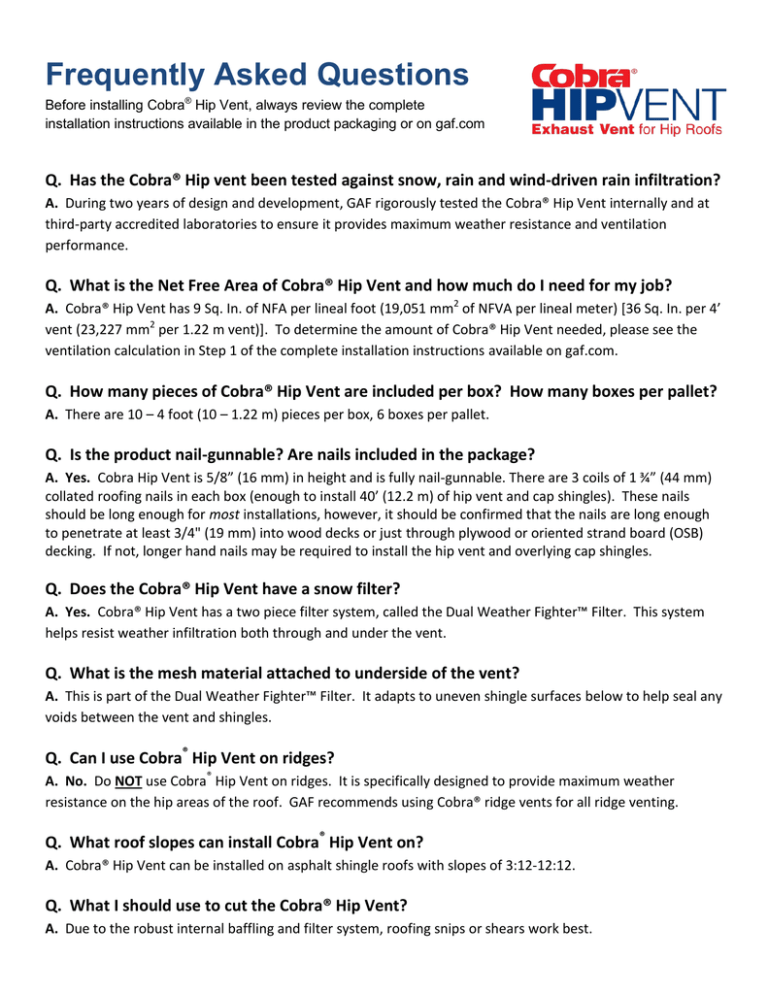Frequently Asked Questions
advertisement

Frequently Asked Questions Before installing Cobra® Hip Vent, always review the complete installation instructions available in the product packaging or on gaf.com Q. Has the Cobra® Hip vent been tested against snow, rain and wind-driven rain infiltration? A. During two years of design and development, GAF rigorously tested the Cobra® Hip Vent internally and at third-party accredited laboratories to ensure it provides maximum weather resistance and ventilation performance. Q. What is the Net Free Area of Cobra® Hip Vent and how much do I need for my job? A. Cobra® Hip Vent has 9 Sq. In. of NFA per lineal foot (19,051 mm2 of NFVA per lineal meter) [36 Sq. In. per 4’ vent (23,227 mm2 per 1.22 m vent)]. To determine the amount of Cobra® Hip Vent needed, please see the ventilation calculation in Step 1 of the complete installation instructions available on gaf.com. Q. How many pieces of Cobra® Hip Vent are included per box? How many boxes per pallet? A. There are 10 – 4 foot (10 – 1.22 m) pieces per box, 6 boxes per pallet. Q. Is the product nail-gunnable? Are nails included in the package? A. Yes. Cobra Hip Vent is 5/8” (16 mm) in height and is fully nail-gunnable. There are 3 coils of 1 ¾” (44 mm) collated roofing nails in each box (enough to install 40’ (12.2 m) of hip vent and cap shingles). These nails should be long enough for most installations, however, it should be confirmed that the nails are long enough to penetrate at least 3/4" (19 mm) into wood decks or just through plywood or oriented strand board (OSB) decking. If not, longer hand nails may be required to install the hip vent and overlying cap shingles. Q. Does the Cobra® Hip Vent have a snow filter? A. Yes. Cobra® Hip Vent has a two piece filter system, called the Dual Weather Fighter™ Filter. This system helps resist weather infiltration both through and under the vent. Q. What is the mesh material attached to underside of the vent? A. This is part of the Dual Weather Fighter™ Filter. It adapts to uneven shingle surfaces below to help seal any voids between the vent and shingles. Q. Can I use Cobra® Hip Vent on ridges? A. No. Do NOT use Cobra® Hip Vent on ridges. It is specifically designed to provide maximum weather resistance on the hip areas of the roof. GAF recommends using Cobra® ridge vents for all ridge venting. Q. What roof slopes can install Cobra® Hip Vent on? A. Cobra® Hip Vent can be installed on asphalt shingle roofs with slopes of 3:12-12:12. Q. What I should use to cut the Cobra® Hip Vent? A. Due to the robust internal baffling and filter system, roofing snips or shears work best. Q. How do I cut the air slots on the hip for this product? A. Starting 12” (305 mm) down from the top of the hip (nearest the ridge), mark and cut a 2.5” wide x 36” (64 mm x 914 mm) long air slot centered over the hip rafter. This creates a ½” (13 mm) wide air slot on both sides of the hip rafter. Q. The plywood or OSB roof deck seam intersects the area where I am cutting the hip air slot, what should I do? A. On plywood or OSB roof decks, where a sheathing seam intersects the hip air slot, stop cutting the air slot 2” before the seam and continue cutting the slot 2” after the seam, leaving a total of 4” of uncut deck at the seam. Then, proceed with cutting down to the previously marked 36” point. This detail will help keep the seam area attached to the hip rafter for increased strength. The air slot can be widened, in this case, to 5/8” on each side of the hip rafter to maintain proper NFVA. Note: Re-nail or reinforce any tongue and groove decking or plywood/OSB sheathing in the area of the hip air slots, as needed Q. After I cut the first hip air slot, what’s next? A. Drop down 12” (305 mm), leaving 12” (305 mm) of uncut roof deck, then mark and cut another 2.5”wide x 36” long (64 mm x 914 mm) hip air slot. Continue this separated hip air slot pattern down only to the midpoint of the hip and at least 24” (610 mm) away from the building’s warm wall. Q. Why do I need to leave 12” (305 mm) of uncut roof deck between every hip air slot? A. The hip areas of the roof are critical for structural integrity. Cutting a continuous hip air slot can affect structural integrity of the roof. Always leave 12” (305 mm) of uncut deck between each hip air slot. Q. Should I continue cutting the hip air slots all the way down to the eave edge? A. No. Never cut hip air slots below the midpoint of the hip. Cutting the hip air slots below the midpoint of the hip can potentially cause the vent to become an intake vent. Keeping hip air slots at least 24” (610 mm) away from the building’s warm wall helps avoid in ice dam issues. Q. The hip air slot nearest to the midpoint of the hip is less than 36” long. Is that OK? A. Yes. Depending on the each roof’s dimensions, the bottom-most hip air slot nearest the midpoint of the hip or 24” (610 mm) from the building’s warm wall will often vary in length. Q. Since hip air slots are NOT cut below the midpoint of the hip, should I install Cobra Hip Vent the entire length of the hip? A. Yes. For optimal aesthetics, GAF recommends installing Cobra® Hip Vent the entire length of the Hip (eave to ridge). Any vent sections installed below the midpoint of the hip must NOT be vented and does NOT count toward the exhaust net free venting area required for the roof. Q. Does the Cobra® Hip Vent need to be installed in a particular direction? A. Yes. Cobra® Hip Vent must always be installed with the “Towards Peak” arrows, located on the top of the vent, pointing up the hip towards the peak. This is critical for a weather-resistant installation. Q. With the hip air slots cut, how do I begin installing the hip vent? A. Begin at the bottom of the hip (nearest the eave edge) and install two cap shingles. This helps ensure the junction between the two roof planes is weather resistant. With the “Towards Peak” arrows on the top of the vent pointing up the hip towards the peak, center the first Cobra® Hip Vent section on top of the cap shingles. Position the hip vent as close to the eave edge as possible, ensuring there is no overhang. Q. How do I fasten this first vent section into place? A. Using the included 1 ¾” (44 mm) collated roofing nails and pneumatic nail gun, fasten the vent 6” (152 mm) on-center using the “Fasten Vent Here” circular targets located on the top of the vent. Q. With the first 4’ (1.22 m) section of Cobra Hip Vent fastened into place, what’s next? A. Working up the hip, fasten subsequent hip vent sections using the inscribed “Fasten Vent Here” targets. Insure the “Towards Peak” arrows on all vents point up the hip towards the peak. Always ensure there are no gaps between the bottom of the vent and the field shingles below. Q. At minimum, how far should the Cobra® Hip Vent extend past the top and bottom hip air slots? A. For maximum weather resistance, Cobra® Hip Vent must always extend at least 12” (305 mm) past the bottom or top hip air slots. Q. Can I install Cobra® Hip Vent with Ridge Vents? A. Yes. Always install ridge vents first and run the ridge vent the entire length of the ridge, terminating the ridge vent as close to the hip junction as possible. Q. Once I reach the top of the hip, what do I do with the final vent section? A. Position the vent with “Towards Peak” arrows pointing up the hip. Cut the final vent section to size, ensuring a built-in end cap remains on the side nearest the ridge. Miter cut the final hip vent to fit next to any adjacent hip vents and ridge vent (if present). Cover all joints at the hip and ridge junction with a 3” (76 mm) wide strip of GAF peel and stick leak barrier. Q. If I’m using Cobra® Hip Vent with a ridge vent, how do I join the hip vent and ridge vent together? A. See the included hip-to-ridge miter instructions included in the complete installation instructions. A miter template is also included to help assist in the process. Q. With all the Cobra® Hip Vents installed, how do I complete the installation? A. Using the included 1 ¾” (44 mm) collated roofing nails and pneumatic nail gun, proceed with installing hip and ridge cap shingles over the hip vent utilizing the inscribed “Shingle Nail Zone” located on the top of the vent. These nails should be long enough for most installations, however, it should be confirmed that the nails are long enough to penetrate at least 3/4" (19 mm) into wood decks or just through plywood or oriented strand board (OSB) decking. If not, longer hand nails may be required to install the hip vent and overlying cap shingles. Still have questions? Please call GAF Technical Services at 1-800-766-3411 © 2014 GAF 7/2014 www.gaf.com






